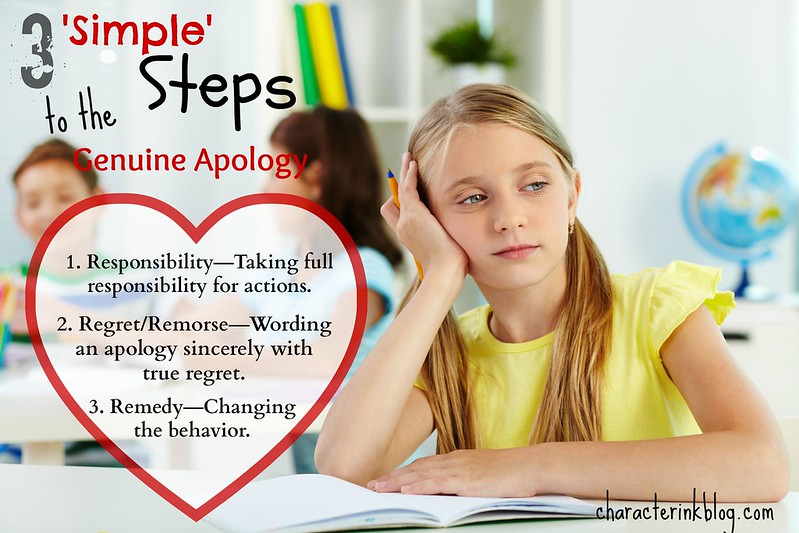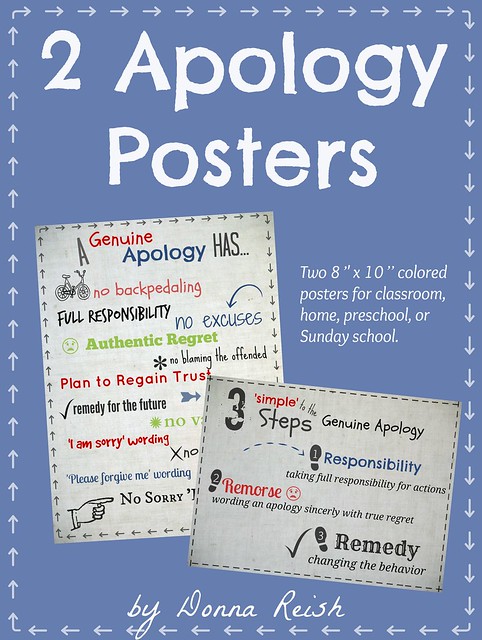A couple of days ago I wrote about how to teach your kids NOT to apologize based on The View’s apology to the beauty pageant nurse. In going through the steps to teach your kids what to do and not do in apologizing, it was uncanny how many things the co-hosts on that program did in the “what not to do when you apologize” list.
There are many formulae out there for teaching the apology, and most of them are correct as they focus on the basics:
(Download this poster here)
I’m all about mnemonics—using jingles, rhymes, clues, abbreviations, and more to teach children (and adults). I’m all about alliteration (thus, the All About Alliteration…sorry!). I’m also all about making things easier for kids to learn.
So rather than the four, five, or even seven steps (which are all important), I bring you three steps to the genuine apology…with some substeps. 🙂 (I’m also all about outlining and sub-steps!)
Let’s take these apart for teaching purposes:
1. Responsibility: Taking full responsibility for actions (in your mind and heart first).
This is often the hardest step for people (adults and children) because to take full responsibility means that we are not holding the other person responsible for anything they did.
We are a society of victims (even when it isn’t legit). It is often hard for us to believe that something is entirely our faults.
In the responsibility step, we must teach our children that a genuine apology has the offender taking full responsibility for his actions—with no concern for what the other person may have done.
(This step can actually be “taught” in an ongoing manner in our homes (not just during apologies) by working on two character qualities: empathy and humility. Check out this blog post for help in teaching these traits to your children.)
Be sure you teach some important aspects of this step:
a) Responsibility means using clear wording to describe exactly what you did. No vagueness. No “if I did anything.” No “misunderstanding.”
b) Responsibility takes the entire blame (without holding the other person hostage to apologize in order for you to admit your part).
c) Responsibility avoids words like if, but, you also, you misunderstood, sorry for the misunderstanding, etc.
2. Regret/Remorse: Wording an apology in such a way that true remorse is communicated.
If a person did not take full responsibility for his actions, this regret/remorse step will be hard to get to. You simply cannot truly regret something you “might” have done or something that was “misunderstood” by the other person.
If a parent is forcing an apology, this step will be short, clipped, and insincere. It will be whatever it takes to end the apology.
Because of this, we recommend that you use truly remorseful statements (as opposed to “I want to ask you to forgive me” or “I hope you will forgive me” or “I wanted to apologize”).
Here are some important aspects of this step:
a) Wording should be that of taking full responsibility AND genuine remorse
i. I am sorry that I _______________________ (list what the offender did)
ii. Please forgive me for doing this.
b) A remorseful apology does not bring up what the other person did.
c) Note: We taught our kids that perception is reality. If the person thought you did it, to that person, you did it. Don’t apologize for the person thinking you did it. Apologize for doing it.
3. Remedy: Taking steps to prove to the offended that you are changing your behavior in that area.
A true apology ends with the offended one being convinced that the offender will not repeat the offense. Now, nobody is perfect, and it might happen again! However, the offended one should feel that the person really plans to not repeat the offense and is actually planning steps to stop it from happening again.
Children will often need a lot of help with this step. Coaching at this stage might sound something like, “Johnny, now that you know that you have hurt Susie with that behavior. What can you do to be sure that you don’t do it again?”
Eventually, as you carry out the three steps with your children, they will not need as much coaching in each step, but this last one might take some creativity on your part to help the offender come up with behaviors and steps that will end the hurtful actions.
The “Simple” is in the title because while there might be three words, three simple steps, the carrying out of these is anything but simple.
But forgiveness is worth it. Humility and empathy are worth spending time on in the lives of our children.
Click on the picture below to download 2 printable posters about what an apology IS 🙂







Interesting concept! How about a two-parter: How to receive a compliment in one and how to receive an apology in another? 🙂 Thanks for commenting. I’ll get to work on that!